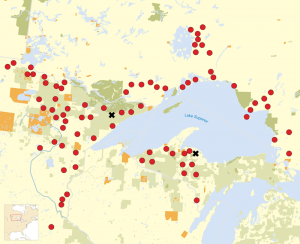Reprinted with permission from Louis V. Galdieri’s blog.
On the Almanac program I discussed in yesterday’s post, Kathryn Hoffman cited “42 exceedances of water quality standards” at Eagle Mine to make the point that reverse-osmosis technology isn’t as effective as mining proponents in Minnesota make it out to be. I was expecting some rundown of those exceedances in Codi Kozacek’s January 8th article about Eagle Mine on Circle of Blue; but Kozacek focuses, instead, on the Eagle Mine water-monitoring agreement Rio Tinto struck with Superior Watershed Partnership and Land Trust two years ago.
It’s not hard to see why. Kozacek seems to have traveled from Hawaii (where she’s based) to the UP to do some interviews and take some photographs: it appears she was there in summertime. But so far as I can tell she’s based her article on a “case study” jointly commissioned by Rio Tinto and the Superior Watershed Partnership, a piece of bespoke research entitled Unity of Place: Giving Birth to Community Environmental Monitoring.
In fact, the opening of Kozacek’s article documenting – or should I say celebrating? — this “unprecedented” water-monitoring agreement seems to be nothing more than a loose paraphrase of that publication, which tells the story of how the community around Eagle Mine gained “a measure of power over the mine. And it was Rio Tinto that gave it to them.”
Leave aside for the moment the preposterous idea that that power was Rio Tinto’s to give in the first place: the Unity of Place case study simply asks us to accept that business can and will decide the power society has over it, and Kozacek seems untroubled by the notion. That Rio Tinto sold Eagle Mine to Lundin Mining after descending from the heights to strike this unprecedented power-sharing agreement with the little people living around the mine does not give her pause, or raise questions about the mining giant’s good faith or much-touted commitment to the community around Eagle; and Kozacek only gets around to mentioning the sale to Lundin 28 paragraphs into her 34-paragraph story.
For the sake of balance, she includes a couple of interviews with “skeptics,” people who remain, to this day, distrustful of the water monitoring agreement but express the hope that it will have some good effect. She mentions the uranium leakage discovered at Eagle last year, which she offers as proof of the success of the program in alerting “the public to potential water quality threats,” quoting the Superior Watershed Partnership’s Jerry Maynard (who is also featured prominently in Unity of Place): the monitoring program, he says, “is gaining the trust and respect of the community….We want this to get out there—we want other mining communities to say ‘we want this too.’” But she fails to mention any other exceedances or violations – I guess she missed that episode of Almanac before filing her story — and apparently didn’t bother looking into the new water story now unfolding around Eagle Mine: the renewal of the mine’s groundwater discharge permit. (Michele Bourdieu has that story over at Keweenaw Now.)
My guess is that Kozacek is unfazed by any of these questions and complications, because the real story she wants to tell here is the story of a mining “renaissance”: she uses the word a few times in her article, once as a header and then twice in the body:
The Eagle Mine is viewed as either on the leading edge or the troubling future of a mining renaissance in Michigan’s Upper Peninsula, a region that has seen more mining bust than boom in the past 50 years. Just as in the oil and gas industry, improvements in mining technology are making previously overlooked ore bodies economically attractive. Rapidly developing countries, particularly China and Brazil, are driving demand for iron, copper, nickel, silver, and gold.
But many of the once booming mine communities in the U.P. and northern Wisconsin, operating with a fraction of their historical populations and downtowns darkened by empty storefronts, are eager for a mining renaissance.
Not a return of mining. Not a re-opening of the mines. Not a new mineral leasing, exploration and mining boom (which would have to be followed by yet another bust). A mining renaissance. It’s an odd word for someone writing about water issues to choose. I wonder if the ungainly use of the word “birth” in the subtitle of the Rio Tinto-Superior Watershed case study inspired Kozacek here: with the “Birth” of “Community Environmental Monitoring” advertised on the cover and on every recto page of that pamphlet, why not imagine a rebirth – and wouldn’t the word “renaissance” be so much more elegant? – of mining?
Renaissance miners, in the early 16th-century stained glass window of the Villanders parish church.
It’s at best an ugly parody of historical discourse, but I take it that it’s intended to give the new mining around Lake Superior a historical stature that it would otherwise seem to lack. In the second of the two paragraphs I’ve quoted here, Kozacek even imagines the area longing to emerge from a kind of Dark Age, or at least “darkened” downtowns, into renewed prosperity.
But in the first of those paragraphs, I must admit, she does a pretty good job of spelling things out. New extractive technologies have made it not only possible but “economically attractive” (read: highly profitable) for large multinational players to mine previously neglected or abandoned ore deposits, extract oil from tar sands and drill for natural gas by fracking. Chinese urbanization and rapid development in the BRIC countries continue to drive and raise demand for minerals and fossil fuels, as economic power shifts away from developed, Western economies.
Communities in the Upper Peninsula and all around Lake Superior are now feeling the pressures of these bigger changes. Whether they will bring renewal — or more boom and bust, or just catastrophic demise – is another question altogether.
—
Read more from Louis V. Galdieri at lvgaldieri.wordpress.com.




 WaterLegacy is collaborating with Friends of the Boundary Waters to promote Sulfide Mining Awareness Day on June 22.
WaterLegacy is collaborating with Friends of the Boundary Waters to promote Sulfide Mining Awareness Day on June 22.  “With the entire Great Lakes region under threat, we have to band together to protect our beautiful homeland, and keep our precious water safe for the generations to come.”
“With the entire Great Lakes region under threat, we have to band together to protect our beautiful homeland, and keep our precious water safe for the generations to come.”